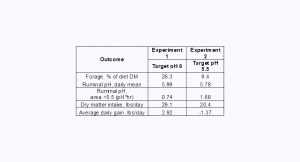 Feb 1,2020
Feb 1,2020

In dairy cattle, rumen pH fluctuates considerably by 0.5 to 1pH unit during the 24 hours’ period. Rumen pH is determined by the dynamic balance between the intake of fermentable carbohydrates, buffering capacity of the rumen, and rate of acid absorption from the rumen.
Sub-Acute Ruminal Acidosis (SARA) is most commonly defined as a repeatedly occurring prolonged period of depression of the ruminal pH to values between 5.6 and 5.2. The low ruminal pH is caused by excessive accumulation of volatile fatty acids (VFAs) without persistent lactic acid accumulation and is often restored by the animal’s own physiological response.There are no apparent symptoms of SARA and mostly such cases remain untreated.
Repeated episodes of SARA make the animal susceptible to ruminal acidosis.
Rumen of dairy cattle is an important organ where majority of the digestion takes place. It is considered as one of the most concentrated microbial habitats in the world. Rumen, as such does not secrete any enzyme and rumen microbes are responsible for all the digestive activities over there.
• Feeding high concentrate and low roughage/fibre diet
• Shifting from high forage to high concentrate diet
• Switching from silage to high levels of green chop forage
• Low fiber content in diet; < 30% NDF and < 19% forage NDF (% of ration DM) • Diet composed of very wet and highly fermented feeds; >52% moisture
• Feeding very finely chopped forage
Symptoms of acidosis start with limited cud chewing and subsequent drop in production. Milk fat and SNF content also goes down. Non-infectious diarrhea is another common finding in such cases. Laminitis can be observed in later stages.
Reduced dry matter intake becomes especially evident if the ruminal pH falls to below or near about 5.5. Feed intake does not appear to be limited as long as ruminal pH remains above 5.5; however, pH values lower than this appear to strongly decrease dry matter intake.
Effect of target ruminal pH on actual ruminal pH, dry matter intake, and average daily gain in Holstein steers:

• Decreased milk production
• Less milk fat
• Decreased fibre digestion
• Ruminal atony
• Diarrhea
• Lameness
• Ruminitis
In India, few farms practice feeding Sodium bicarbonate or a combination of Sodium bicarbonate and Magnesium oxide. This helps to manage acidic condition for a short while whereas, associated issues like endotoxin release remain unaddressed which lead to conditions like laminitis and once these situations develop, we can imagine the losses that they will cause.
Management of ruminal acidosis should be a holistic approach. Merely neutralizing the acid produced will not serve the purpose.
• Binding endotoxins produced in rumen due to acidic environment
• Neutralizing the elevated acidic pH of the rumen and normalizing it instantly.
• Maintaining the rumen pH within normal range for longer periods
• It should have a faster solubility in rumen liquor
Studies have proved that feeding a combination of sodium salt of carbonic acidand oxides of magnesium help to manage rumen pH within normal range. A combination with an endotoxin binder like HSCAS (Hydrated Sodium Calcium Alumino Silicate) makes it a complete solution for rumen acidosis and related problems.
Sodium bicarbonate has two important roles, as a buffer and a source of sodium to meet the sodium requirements and help to provide a positive dietary cation-anion balance.
Magnesium oxide is a slow releasing neutralizing agent because of its relative insolubility in water and helps to manage rumen pH for longer periods.
Hydrated Sodium Calcium Alumino Silicate (HSCAS) has got excellent toxin binding properties. It binds with endotoxins released from dead microbes in the rumen due to decrease in ruminal pH which otherwise can cause laminitis in the affected animal.